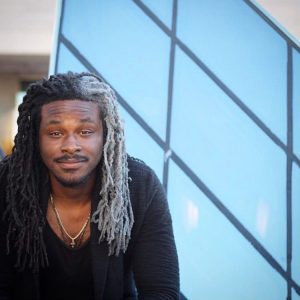Processing Archivist Juli Folk shares her findings in the Phillips Archives about Conceptual Artist Yuri Schwebler.
Since I began working as a processing archivist in The Phillips Collection Library and Archives this summer, one of the resources I access to learn more about the museum is our rich collection of oral histories, a documentation effort that began in 2004 and continues today. These transcripts are the result of hours of conversations between professional oral historians and The Phillips Collection directors, curators, exhibition designers, artists, and other staff. While reading the oral history with Bill Koberg, The Phillips Collection’s chief of installations who started as a museum assistant in 1971, I was struck by his passing mention of a familiar outdoor sculpture around the corner from the museum.
“Now that you’ve scratched my memory, there was a Yuri Schwebler [show at The Phillips Collection in 1973], and those were works that were designed for the space that were made out of slate and, I think, in some cases, glass on rails with pendulums. There’s an example of that, now, on Q Street, around the corner, in front of a… house.”
If you’ve ever walked to The Phillips Collection from the Dupont Circle Metro station via Q Street NW, then you’ve probably seen it, too. The work, by conceptual artist Yuri Schwebler, sits in front of a muted green house on the north side of the street.
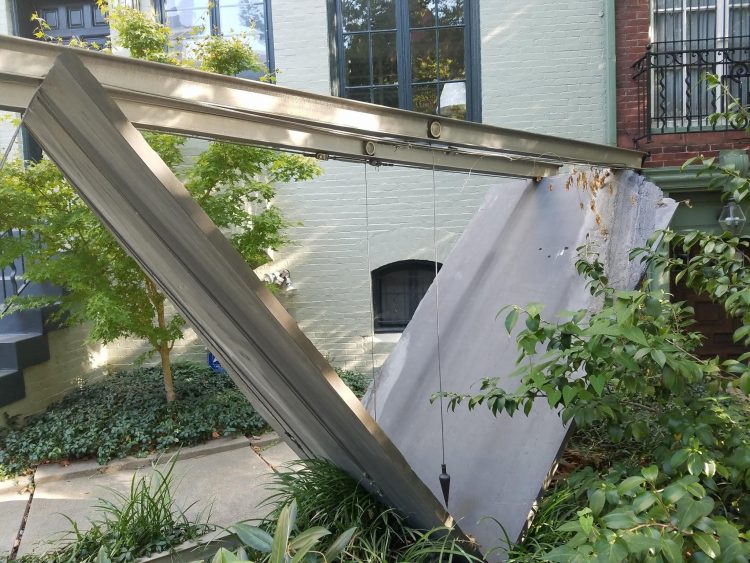
Sculpture by Yuri Schwebler. Photo: Juli Folk
Schwebler, a well-known participant in the 1970s DC arts scene, was born on November 21, 1942, in Nazi-occupied Feketic, Yugoslavia. He immigrated to Delaware as a child, taking art lessons in high school and eventually attending Western Maryland College before being encouraged to pursue his art career in Maryland and DC. He is best known for ambitious works designed for specific sites and is associated with the Max Protetch gallery. The piece on Q Street NW is exemplary of the concepts Schwebler was exploring at this time, including geometry, balance, light, shadow, and natural processes.
Schwebler’s 1973 exhibit at The Phillips Collection, 2 as 3 sculptures, is an early exploration of themes that would pervade his career.

Exhibition Postcard. Image courtesy of The Phillips Collection Archives
ttps://
The exhibition brochure shows that the five works emphasize pendulums, plumb bobs, materials, and spatial balance. As Koberg noted, the pieces were designed specifically for the courtyard space.
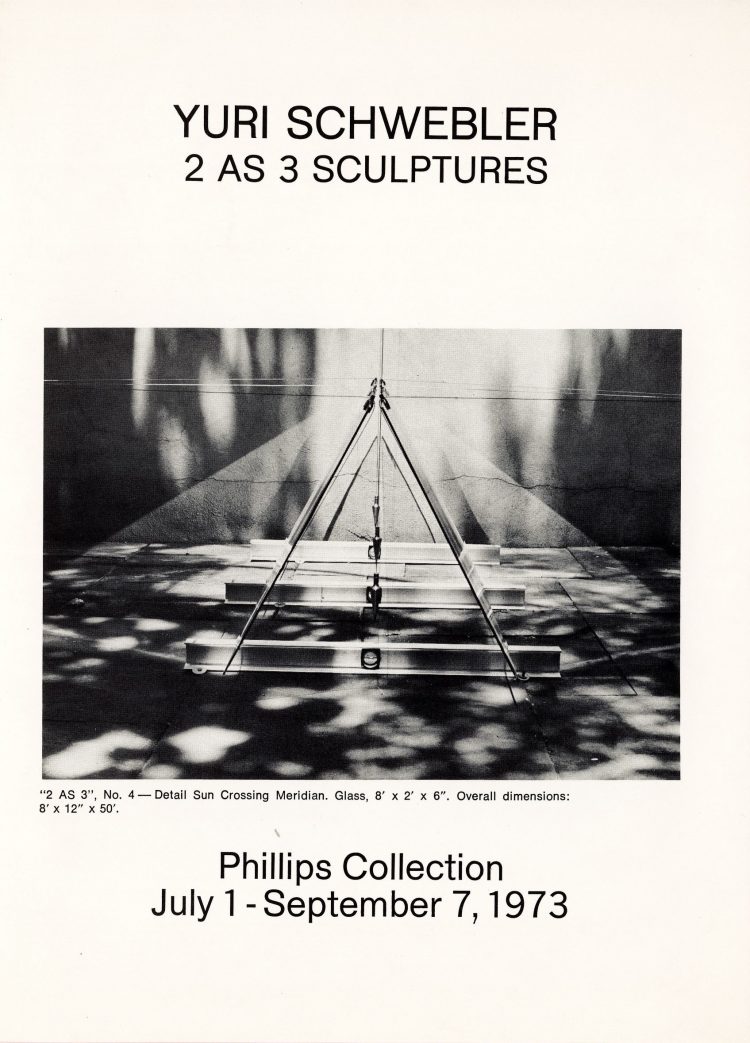
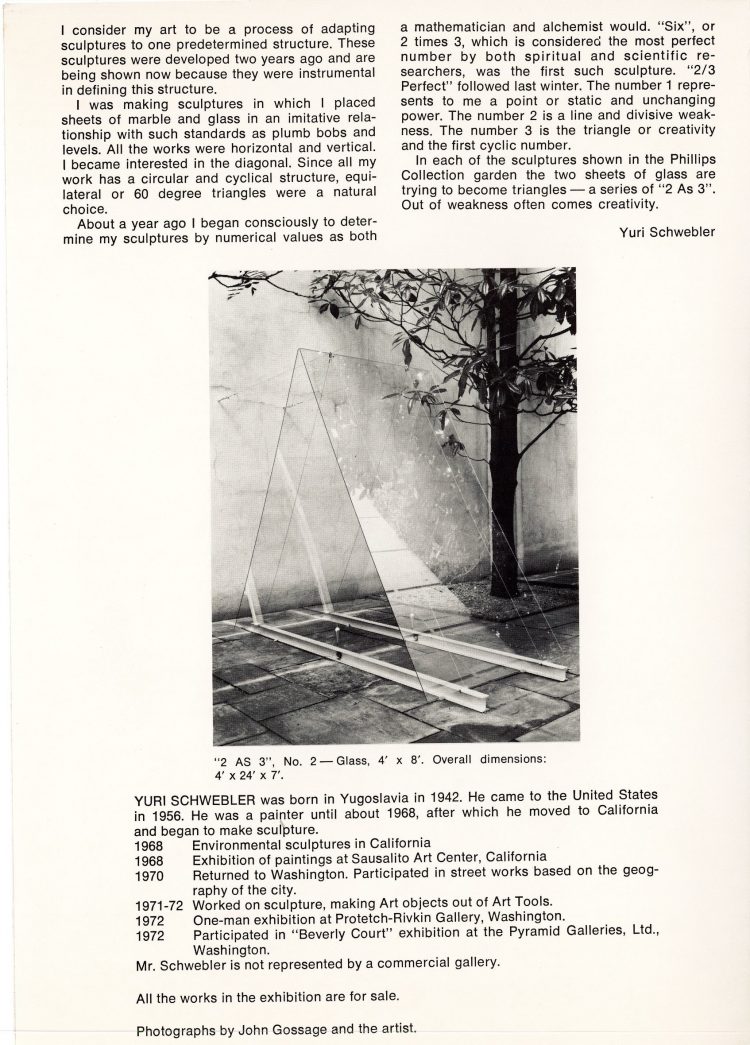
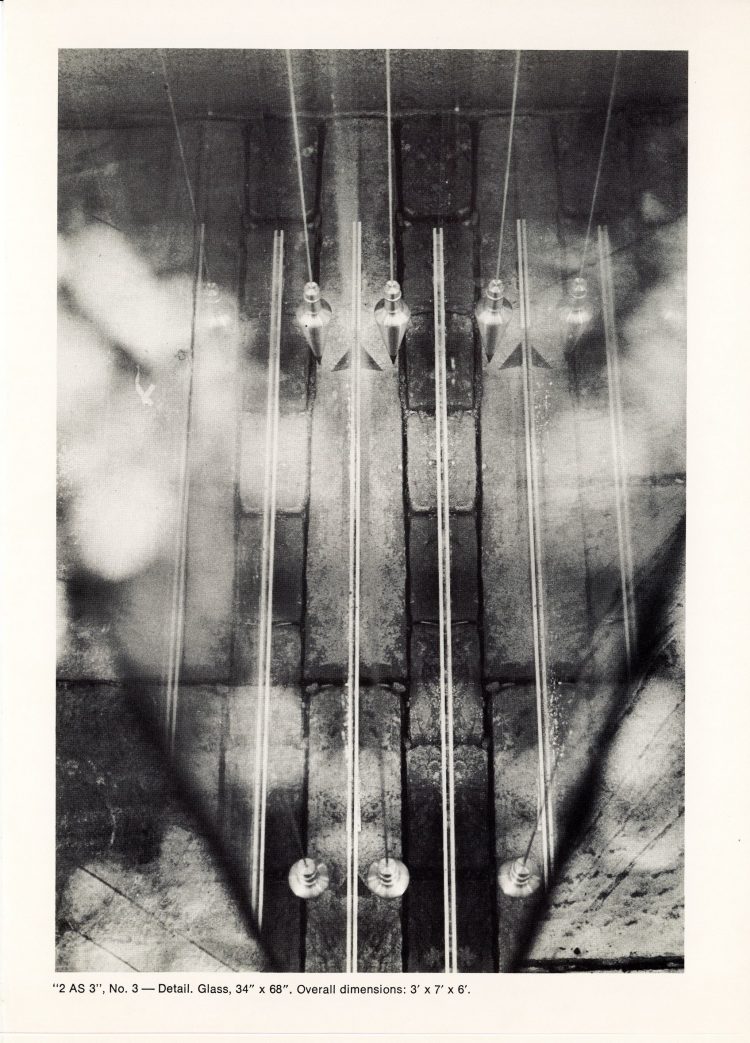
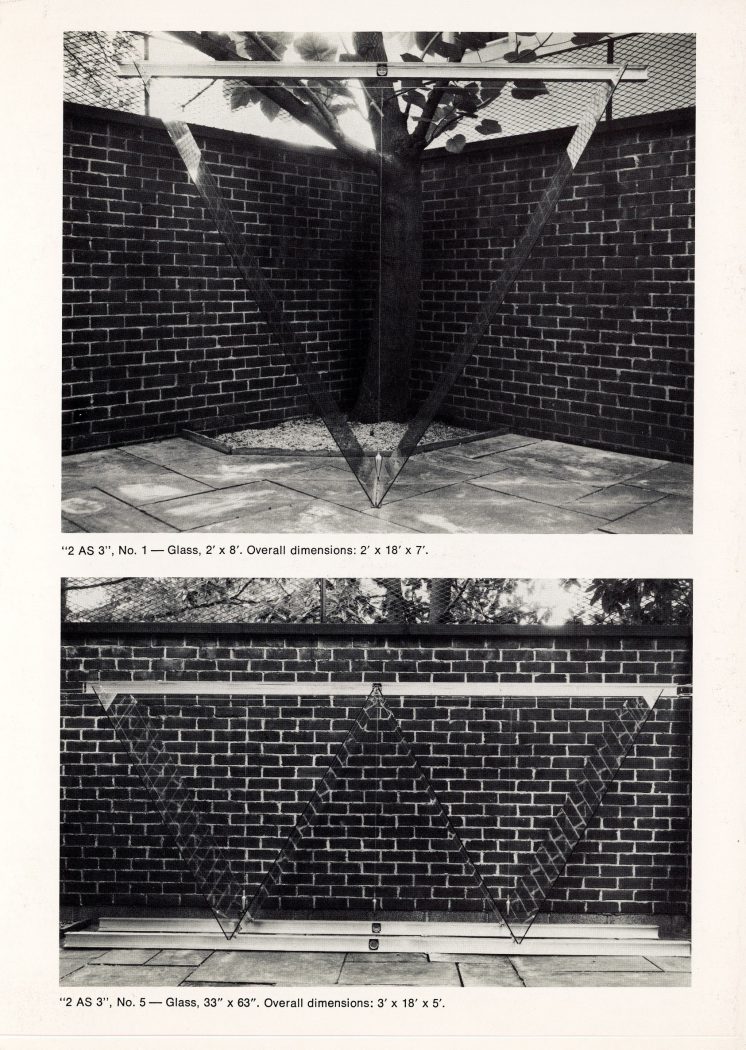
Henry Allen, writing for The Washington Post Arts in 1973, called the show “sculpture in the tradition of the pyramids, not the Pieta—of alchemy rather than esthetics.” Allen goes on to describe that, “The five new works comprise: 12 big sheets of 1⁄4-inch plate glass, 11 aluminum I-beams, each with a small hole drilled in the center to hold a carpenters’ spirit level, 11 plumb bobs that dangle from 11 golden strings, and 26 turnbuckles to tighten 13 silvery wires.”
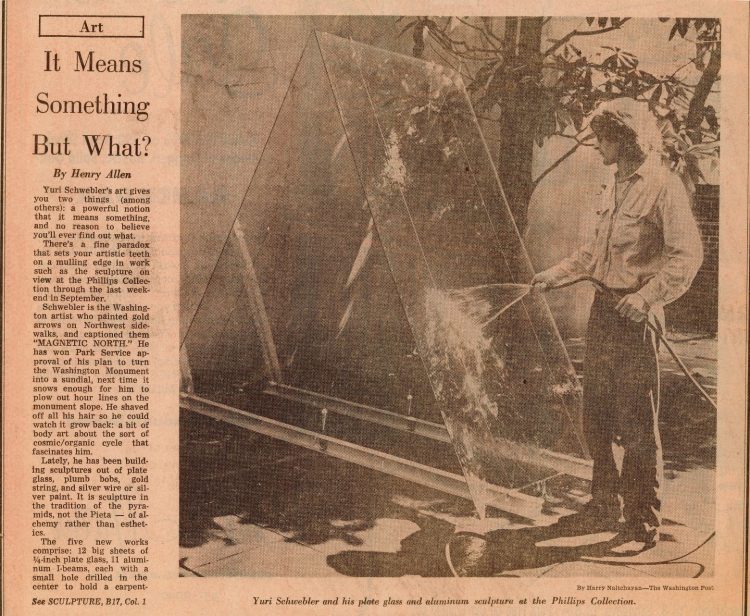
The Washington Post Review
A 1981 essay by Lynda Roscoe Hartigan for an exhibition organized by The Hudson River Museum, The Studio: Sculpture by Yuri Schwebler, describes Schwebler’s works as sometimes temporary and sometimes permanent, constructed both indoors and outdoors, and exploring “geometric precision and modules to magical transformations and theatrical engagement, from small wall-oriented objects to projects of monumental proportions”.
Spatial drawings of geometric figures based on numerical values (as in both mathematics and alchemy, according to Schwebler) were refined on increasingly larger scales between 1973 and 1978. In five sculptures made in 1973 specifically for the garden of The Phillips Collection, Schwebler arranged in each work two sheets of plate glass to suggest equilateral triangles (“2 as 3”) resting on or under aluminum I-beams. The measure of each piece for balance and precision was taken in effect by carpenter’s spirit levels and plumb bobs on golden threads, while taut silver wires both secured the constructions and extended the image of drawing between points and planes in space. Industrial hardware and pristine glass were combined to reveal both structure and process. Catching light and elements in the space around them, each transparent variation acquired a certain poetry in harmony with its environment—a foil to formal crispness.
Other popular local works included filling the atrium of the Corcoran School of Art with pyramids and a series of “Magnetic North” installations around the District. In the winter of 1974, after years of planning, Schwebler created a sundial using the Washington Monument as its gnomon shifting against the carefully calculated pattern shoveled into fresh snowfall. Walter Cronkite reported for the CBS Evening News that the project required $24, six feet of snow, and a permit and plow from the National Park Service. When asked about why he made it, Schwebler replied, “You can actually see the Earth move, or feel it move, by watching that shadow.”
Again, Hartigan quotes Schwebler’s take on his work around DC.:
“Relating [is] what I’ve done in those pieces over the years rather than sculptures… around this town [Washington, DC], looking at sculpture that exists—like a general here and a horse and general there—[it] is always imposing on the space but… dealing with the structure of the space, and somehow showing something that I saw in the place, rather than really imposing myself.”
Sadly, Schwebler died by suicide at his home in Marlborough, New York, on March 3, 1990, at age 47, and his obituary appeared in The Washington Post. He was survived by his partner, Enid Sanford, as well as his mother, Eva Schwebler, and two sisters. Because so much of his work was temporary by design, many installations are no longer in existence; the piece on Q St. NW is thus an even more poignant reminder of his artistic efforts and local legacy.
—
The Phillips Collection Archives was established in 2006 to organize, preserve, and make available the museum’s records of enduring value that document the history of the museum, including its origins, activities, and events. The Archives serves as the museum’s institutional memory, and is especially rich in documentation of Duncan and Marjorie Phillips, the museum’s founders. The Archives also selectively acquires primary source material that relates to the history of the museum as well as collections that focus on artists whose work is in The Phillips Collection. The archives welcome staff as well as visiting researchers and scholars during public open hours as well as visits by appointment. Research conducted by staff and visiting scholars leads to exhibitions, exhibition catalogues, books, articles, theses, and doctoral dissertations.
Resources and Further Reading
Allen, Henry. “It Means Something But What?” The Washington Post, July 20, 1973.
Anderson, John. “The Missing Archive of Yuri Schwebler.” International Sculpture Center re:sculpt, January 25, 2017. https://blog.sculpture.org/2017/01/25/the-missing-archive-of-yuri-schwebler/.
Caldwell, John. “Art; Thought-provoking Work At The Hudson.” The New York Times, November 15, 1981. https://www.nytimes.com/1981/11/15/nyregion/art-thought-provoking-work-at-the-hudson.html
Frgey, Benjamin. “Phillips Collection: A Sculptural Side.” The Washington Star-News, July 20, 1973.
Hartigan, Linda. “The Studio: Sculpture.” Hudson River Museum Exhibition Catalog, 1981. https://books.google.com/books?id=7vbldwPxOfkC.
Meyer, Robinson. “On Google Maps, the Washington Monument Is a Sundial.” The Atlantic, May 23, 2014. https://www.theatlantic.com/technology/archive/2014/05/on-google-maps-the-washington-monument-is-a-sun-dial/371555/.
Meredith. “DC Art History: Yuri Schwebler and the Largest Sundial.” Brightest Young Things,
March 9. 2010. https://brightestyoungthings.com/articles/dc-art-history-yuri-schwebler-and-the-largest-sundial.
Metcalfe, John. “Queen of Beverly Court.” Washington City Paper, July 2, 2004. https://www.washingtoncitypaper.com/news/article/13029304/queen-of-beverly-court
Moorhaus, Donita. Transcript of an oral history in The Phillips Collection Oral History Program: Interview with Bill Koberg, The Phillips Collection Library and Archives, 2010. http://library.phillipscollection.org:8080/#section=resource&resourceid=257980
Pearson, Richard. “Yuri Schwebler, D.C. Artist in 1970s, Dies.” The Washington Post, March 5, 1990. https://www.washingtonpost.com/archive/local/1990/03/05/yuri-schwebler-dc-artist-in-1970s-dies/f1626044-8a11-4d06-8de6-1da77b08bdad/.
Richard, Paul. “Phillips: A Look at the Locals.” The Washington Post, September 15, 1973.
Seadler, Dee. “ART: Schwebler Through the Looking Glass.” Memo: Washington’s Comprehensive Entertainment Magazine. August 19-September 1, 1973, p. 14.






